Main Menu
Latest Blog Entry
User login
“The true Art to what, how and why we do”: Jim Radcliffe
What it takes to be a successful strength and conditioning coach.
“People in support positions should be seen and not heard” 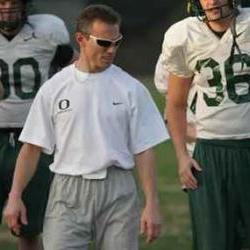 Jim Radcliffe at the beginning of his presentation on successful S&C coaching.
Jim Radcliffe at the beginning of his presentation on successful S&C coaching.
(By successful, he means producing extremely fit, agile and fast athletes that then produce results on the field, court, track or pool. Rather than how many twitter followers you have got!)
Successful coaches explain the “Why”
Most coaches are good at telling athletes the what to do, some are really good at explaining the how, but very few are great at understanding the Why.
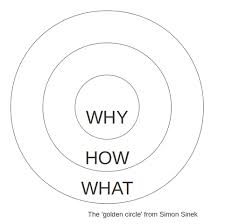 Radcliffe explained this at the outset, based on Simon Sinek’s Golden Circle, coaches need to understand why they are doing things, before they start just doing exercises or drills.
Radcliffe explained this at the outset, based on Simon Sinek’s Golden Circle, coaches need to understand why they are doing things, before they start just doing exercises or drills.
His #1 factor of great or elite athleticism is acceleration or burst. The more people in the team who can do this, the better. This is the why.
Rehearse consistently is the “how”
In an average football practice at Oregon, they have 90+ acceleration reps for the exterior positions and 65+ for the interior positions.
This includes burst requiring decision making. An example was his Punt Returners hold lacrosse balls when about to return a punt. This forces them to have correct body alignment and position when they do catch, which then facilitates a burst upfield (a great example of task constraint for you motor learning buffs).
Negative practice drills which detract from the ability to burst must be eliminated. This includes the butt kick drill which just encourages a pendulum swing action and overstriding when running: failure practice!
Thwe warm up is an opportunity for rehearsal, rather than just getting warm. Radcliffe teaches and reinforces push mechanics in every warm up.
“Agility is about efficient transitions”
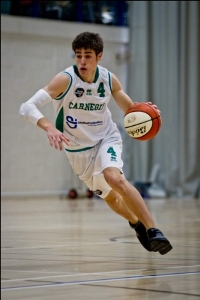 Agility progresses through these stages:
Agility progresses through these stages:
- Start
- Acceleration
- Deceleration
- Change of direction
- Reacceleration
This requires the ability to maintain correct posture as the body flexes, extends and rotates (pic of Excelsior athlete Sean Clifford).
One great tip was to emphasise knee seperation over foot seperation. If the feet are getting further apart than the knees, then it shows poor hip projection.
Ladder drills are redundant because they do a lot of footwork, but do nothing for knee seperation and hip projection.
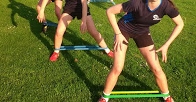 This can easily be seen in drills such as the one pictured with mini bands. The athlete at the front as feet coming out wider than the knees (poor hip projection) the athlete behind has knee above foot (better hip projection).
This can easily be seen in drills such as the one pictured with mini bands. The athlete at the front as feet coming out wider than the knees (poor hip projection) the athlete behind has knee above foot (better hip projection).
Every drill and every athlete must be coached to ensure consistency.
The 2 key points to be emphasised here are
- Body posture cues.
- Increase strength- power-impulse.
How to develop explosive power on the pitch
Being able to apply and strength and power develeoped in the gym onto the pitch requires the ability to apply great force over a small base of support and great righting and tilting reflexes.
Radcliffe said that explosive power can be borken down into 3 areas as shown in diagram below.
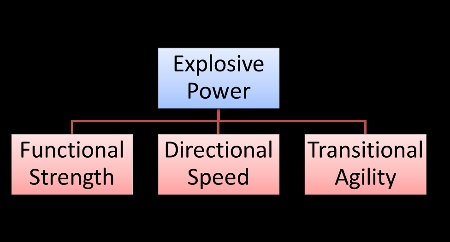
This requires practicing fast, explosive intense movements. Another key point was “The more time spent on the ground =the more BAD things happen than good.”
Here Radcliffe was talking about an athletes’s ability to negotiate the ground. The ability to turn and run fast is a sign of efficient quickness and correct mechanics. There is a need for fast response to a stimulus.
Placing the feet outside the knees is a sign of the less agile athlete: (I question the transference of ultra-wide squats to agility work: hence my athletes squat with feet under hips).
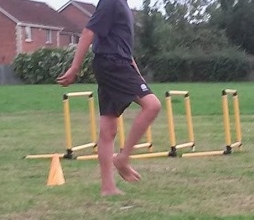 One of the ways to get the athlete to improve mechanics is to train barefoot. This give better immediate sensory feedback about the ability to have a spring loaded foot, rather than a flat foot.
One of the ways to get the athlete to improve mechanics is to train barefoot. This give better immediate sensory feedback about the ability to have a spring loaded foot, rather than a flat foot.
The whole foot lands on the floor, but only a tiny heel mark is left on the grass or sand. A spring loaded foot is essential for running fast and quick turns/ reactive jumps.
Agility drill progressions
Radcliffe spent some time going over how he progresses his agility work with his athletes.
Starting with the two basic actions of:
- Speed cuts: Pivot action, rolling off the inside foot.
- Power cuts: The sit, dip and drive action, pushing off the outside of the foot.
He then progresses to the Sway drill, lateral starts, backward starts and then elastic lead-ins to the the speed and power cuts. This could be stepping off a chair and landing on the outside edge of the foot to push sideways for a power cut.
This then leads to to reaction drills (with directional components such as a clock drill) to a games related skill or drill.
Summary
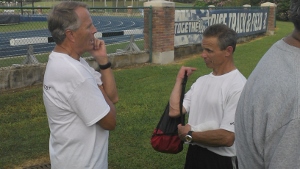 From Day 1, practice 1, Radcliffe emphasises the “Go as fast as you can go” approach to training. Initially this may only be 1/2 steps in different directions, but they are FAST.
From Day 1, practice 1, Radcliffe emphasises the “Go as fast as you can go” approach to training. Initially this may only be 1/2 steps in different directions, but they are FAST.
This seminar showed how Radcliffe has a truly great understanding of Why, brilliant progressions of how, and then practically he can do the what.
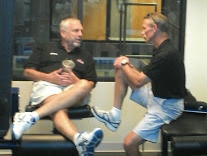 What is really refreshing about Jim Radcliffe, is that he is at GAIN to learn as much as to teach, he is always writing notes, or asking the different presenters questions so he can improve his own practice (see pictures of him sharing with Vern Gambetta and Finn Gundersen).
What is really refreshing about Jim Radcliffe, is that he is at GAIN to learn as much as to teach, he is always writing notes, or asking the different presenters questions so he can improve his own practice (see pictures of him sharing with Vern Gambetta and Finn Gundersen).
This is the 4th year in a row I have seen him present, and I always get something new. I have completely changed how I coach agility and pliometrics as a result of seing him in action. Highly recommended.
Further reading:
- Train the way you play: Jim Radcliffe
- Strength and Power concepts: Jim Radcliffe
- Pliometrics and agility: Jim Radcliffe
- Agility with a purpose: Jim Radcliffe
- Principles of Training (overload variations): Jim Radcliffe.
Client Testimonials
During the build up to the Beijing Paralympics I was fortunate to be able to train with Excelsior. During this time James delivered a specific eleven month training block to me starting from base fitness up to more complex circuits and exercises. James would always take part in our sessions and this really helped motivate me, as we would push each other to achieve during the sessions. James was flexible around my shift work and would always answer any questions I had, however daft they sounded!
More

